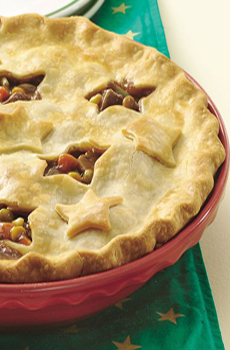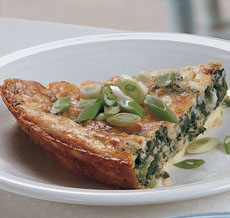TIP OF THE DAY: Bake A Savory Pie For National “Pi” Day
 Make this delicious beef pot pie. Photo and recipe courtesy BettyCrocker.com. |
Remember your high school math: Pi (3.14159) is the ratio of a circle’s circumference to its diameter.
Math geeks have declared 3.14 (March 14th) Pi Day. But we’re adopting it as “Pie Day”; and why not, since a pie is a circle, and you can use pi and the diameter of your pie plate to calculate the circumference. (Lame or a good excuse to bake a pie? You be the judge). Why bake a savory pie instead of a sweet one? The original pies were savory. Fruit pies and other sweet versions did not evolve until the 1300s and later. There are plenty of delicious savory pies, from that American favorite, pot pie, to British steak and Stilton pie. To celebrate St. Patrick’s Day, how about a beef and Guinness pie? The ancient Egyptians, who were great bread bakers, also worked out the details of early pastry. But don’t salivate at the thought of it: Until relatively recently, the pastry was tough, inedible and used as a cooking vessel. Pie was a savory dish scooped from the crust—more like a casserole. |
|
|
In the millennia before baking pans were invented, a dough of flour and water paste was wrapped around meat or fish to soak up the juices as it cooked. Pastry as we now know it was developed in the Middle East (a baklava, made of phyllo dough layered with nuts and honey, was brought to Mediterranean Europe by the Muslims and Greek seamen around the 7th century. What about those noted gourmands, the Romans? Greek and Roman pastry did not progress as far as it could have because both cultures used oil, not butter, which can’t create a stiff pastry. It wasn’t until much later, in medieval Northern Europe, that the traditional use of lard and butter instead of oil for cooking hastened the development of other pastry types. The Renaissance saw a pie-baking boom in England, but still they were meat pies, including the legacies of shepherd’s pie (lamb and vegetables) and cottage pie (beef and vegetable). Both have a mashed potato top instead of top crust. By the 17th century, flaky and puff pastries were in use, developed by French and Italian Renaissance chefs. Pastry began to become highly decorated, with pastry chefs working intricate patterns on the crusts. |
||
|
PIE BAKING TIPS
|
 Easy spinach and Parmesan pie. Photo and recipe courtesy BettyCrocker.com. |
|
|
|
||


